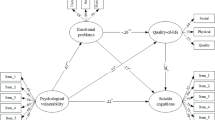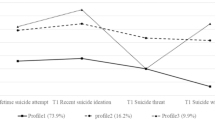Abstract
The present study assessed the association among risk and resilience factors (hopelessness, depression, subjective happiness) that contribute to suicidal behaviors in Italian youth. The sample consisted of 253 Italian high school adolescents (mean age = 18.09, SD = 0.57; 137 males; 116 females) who were administered a demographic questionnaire, the Suicide History Self-Rating Screening Scale, the Beck Depression Inventory II, the Beck Hopelessness Scale, the Attitude Toward Self-Revised Scale, and the Subjective Happiness Scale. Depressive symptoms were positively associated with cognitive vulnerabilities (trait-like tendencies to interpret information in a negative and distorted way when encountering a perceived stressful event) and negatively associated with subjective happiness. Participants with an elevated suicide risk also reported increased depressive symptoms, more cognitive vulnerabilities, and less subjective happiness. Moreover, depressive symptoms significantly mediated the relation between subjective happiness and suicide risk. The findings suggest that in order to prevent suicidal behavior in adolescents, clinicians should consider both risk and protective factors, particularly those that strengthen competencies and build self-esteem. Schools should employ a more positive approach that promotes resilience and enhances protective factors to reduce depressive symptoms and suicidality among youth.

Similar content being viewed by others
References
Abramson, L. Y., Metalsky, G. I., & Alloy, L. B. (1989). Hopelessness depression: a theory-based subtype of depression. Psychological Review, 96, 358–372.
Alloy, L. B., Abramson, L. Y., Whitehouse, W. G., Hogan, M. E., Tashman, N. A., Steinberg, D. L., et al. (1999). Depressogenic cognitive styles: predictive validity, information processing and personality characteristics, and developmental origins. Behaviour Research and Therapy, 37(6), 503–531.
American Psychiatric Association. (2000). Diagnostic and statistical manual of mental disorders (4th ed.). Washington: American Psychiatric Association.
Arbisi, P. A. (2001). Review of the Beck Depression Inventory-II. In B. S. Plake & J. C. Impara (Eds.), The fourteenth mental measurements yearbook. Lincoln, NE: Buros Institute of Mental Measurements.
Balsamo, M. (2010). Anger and depression: evidence of a possible mediating role for rumination. Psychological Reports, 106(1), 3–12. doi:10.2466/PR0.106.1.3-12.
Balsamo, M., & Saggino, A. (2007). Test per l’assessment della depressione nel contesto italiano: un’analisi critica. [tests for the assessment of depression in Italian context: a critical review]. Psicoterapia Cognitiva e Comportamentale, 13, 167–199.
Balsamo, M., Imperatori, C., Sergi, M. R., Belvederi Murri, M., Continisio, M., Tamburello, A., et al. (2013). Cognitive vulnerabilities and depression in young adults: an ROC curves analysis. Depression Research and Treatment, 2013, 407602. doi:10.1155/2013/407602.
Baron, R. M., & Kenny, D. A. (1986). The moderator-mediator variable distinction in social psychological research: conceptual, strategic, and statistical considerations. Journal of Personality and Social Psychology, 51(6), 1173–1182.
Beck, A. T. (1967). Depression: clinical, experimental, and theoretical aspects. New York: Hoeber Medical Division.
Beck, A. T. (1986). Hopelessness as a predictor of eventual suicide. Annals of the New York Academy of Sciences, 487, 90–96.
Beck, A. T. (1987). Cognitive models of depression. Journal of Cognitive Psychoterapy, 1, 5–37.
Beck, A. T., Weissman, A., Lester, D., & Trexler, L. (1974). The measurement of pessimism: the hopelessness scale. Journal of Consulting and Clinical Psychology, 42(6), 861–865.
Beck, A. T., Kovacs, M., & Weissman, A. (1975). Hopelessness and suicidal behavior. An overview, 234(11), 1146–1149.
Beck, A. T., Steer, R. A., Kovacs, M., & Garrison, B. (1985). Hopelessness and eventual suicide: a 10-year prospective study of patients hospitalized with suicidal ideation. American Journal of Psychiatry, 142(5), 559–563.
Beck, A. T., Brown, G., & Steer, R. A. (1989). Prediction of eventual suicide in psychiatric inpatients by clinical ratings of hopelessness. Journal of Consulting and Clinical Psychology, 57(2), 309–310.
Beck, A. T., Brown, G., Berchick, R. J., Stewart, B. L., & Steer, R. A. (1990). Relationship between hopelessness and ultimate suicide: a replication with psychiatric outpatients. American Journal of Psychiatry, 147(2), 190–195.
Beck, A. T., Steer, R. A., Beck, J. S., & Newman, C. F. (1993). Hopelessness, depression, suicidal ideation, and clinical diagnosis of depression. Suicide & Life-Threatening Behavior, 23(2), 139–145.
Beck, A. T., Steer, R. A., & Brown, G. K. (1996). Manual for the beck depression inventory-II. San Antonio: Psychological Corporation.
Carver, C. S. (1998). Generalization, adverse events, and development of depressive symptoms. Journal of Personality, 66(4), 607–619.
Carver, C. S., & Ganellen, R. J. (1983). Depression and components of self-punitiveness: high standards, self-criticism, and overgeneralization. Journal of Abnormal Psychology, 92(3), 330–337.
Carver, C. S., La Voie, L., Kuhl, J., & Ganellen, R. J. (1988). Cognitive concomitants of depression: a further examination of the roles of generalization, high standards, and self-criticism. Journal of Social and Clinical Psychology, 7, 350–365.
David Klonsky, E., Kotov, R., Bakst, S., Rabinowitz, J., & Bromet, E. J. (2012). Hopelessness as a predictor of attempted suicide among first admission patients with psychosis: a 10-year cohort study. Suicide & Life-Threatening Behavior, 42(1), 1–10. doi:10.1111/j.1943-278X.2011.00066.x.
Eisner, L. R., Johnson, S. L., & Carver, C. S. (2008). Cognitive responses to failure and success relate uniquely to bipolar depression versus mania. Journal of Abnormal Psychology, 117(1), 154–163. doi:10.1037/0021-843X.117.1.154.
Evans, E., Hawton, K., & Rodham, K. (2004). Factors associated with suicidal phenomena in adolescents: a systematic review of population-based studies. Clinical Psychology Review, 24(8), 957–979.
Ghisi, M., Flebus, G. B., Montano, A., Sanavio, E., & Sica, C. (2006). Beck depression inventory-second edition. Adattamento italiano: manuale. Firenze: Organizzazioni Speciali.
Green, F., McGinnity, A., Metlzer, H., Ford, T., & Goodman, R. (2005). Mental health of children and young people in great Britain, 2004. Hampshire: Palgrave Macmillan.
Hayes, A. F. (2013). Introduction to mediation, moderation, and conditional process analysis : a regression-based approach. New York: The Guilford Press.
Iani, L., Lauriola, M., Layous, K., & Sirigatti, S. (2014). Happiness in Italy: translation, factorial structure and norming of the subjective happiness scale in a large community sample. Social Indicators Research, 118, 953–967.
Innamorati, M., Pompili, M., Serafini, G., Lester, D., Erbuto, D., Amore, M., et al. (2011a). Psychometric properties of the suicidal history self-rating screening scale. Archives of Suicide Research, 15(1), 87–92. doi:10.1080/13811118.2011.540471.
Innamorati, M., Rihmer, Z., Amore, M., Serafini, G., Rutz, W., Gonda, X., et al. (2011b). Psychometric properties of the Gotland scale for depression in Italian psychiatric inpatients and its utility in the prediction of suicide risk. Journal of Affective Disorders, 132, 99–103.
Innamorati, M., Lester, D., Balsamo, M., Erbuto, D., Ricci, F., Amore, M., et al. (2013). Factor validity of the Beck Hopelessness Scale in Italian medical patients. Journal of Psychopathology and Behavioral Assessment.
Innamorati, M., Tamburello, S., Contardi, A., Imperatori, C., Tamburello, A., Saggino, A., et al. (2013b). Psychometric properties of the attitudes toward self-revised in Italian young adults. Depression Research and Treatment. doi:10.1155/2013/209216.
Jacobs, R. H., Reinecke, M. A., Gollan, J. K., & Kane, P. (2008). Empirical evidence of cognitive vulnerability for depression among children and adolescents: a cognitive science and developmental perspective. Clinical Psychology Review, 28(5), 759–782. doi:10.1016/j.cpr.2007.10.006.
Kessler, R. C., Berglund, P., Demler, O., **, R., Merikangas, K. R., & Walters, E. E. (2005). Lifetime prevalence and age-of-onset distributions of DSM-IV disorders in the national comorbidity survey replication. Archives of General Psychiatry, 62(6), 593–602. doi:10.1001/archpsyc.62.6.593.
Koster, E. H., De Lissnyder, E., Derakshan, N., & De Raedt, R. (2011). Understanding depressive rumination from a cognitive science perspective: the impaired disengagement hypothesis. Clinical Psychology Review, 31(1), 138–145. doi:10.1016/j.cpr.2010.08.005.
Lyubomirsky, S., & Lepper, H. S. (1999). A measure of subjective happiness: preliminary reliability and construct validation. Social Indicators Research, 46, 137–155.
MacKinnon, D. P. (2008). Introduction to statistical mediation analysis. New York: Lawrence Erlbaum Associates.
Maxwell, S. E., & Cole, D. A. (2007). Bias in cross-sectional analyses of longitudinal mediation. Psychological Methods, 12(1), 23–44. doi:10.1037/1082-989X.12.1.23.
Maxwell, S. E., Cole, D. A., & Mitchell, M. A. (2011). Bias in cross-sectional analyses of longitudinal mediation: partial and complete mediation under an autoregressive model. Multivariate Behavioral Research, 46, 816–841. doi:10.1080/00273171.2011.606716.
Patton, G. C., Coffey, C., Sawyer, S. M., Viner, R. M., Haller, D. M., Bose, K., et al. (2009). Global patterns of mortality in young people: a systematic analysis of population health data. Lancet, 374(9693), 881–892. doi:10.1016/S0140-6736(09)60741-8.
Pompili, M., Tatarelli, R., Rogers, J. R., & Lester, D. (2007). The hopelessness scale: a factor analysis. Psychological Reports, 100(2), 375–378.
Pompili, M., Iliceto, P., Lester, D., Innamorati, M., Girardi, P., & Tatarelli, R. (2009a). BHS beck hopelessness scale: Manuale. Firenze: Giunti O.S. Organizzazioni Speciali.
Pompili, M., Masocco, M., Vichi, M., Lester, D., Innamorati, M., Tatarelli, R., et al. (2009b). Suicide among Italian adolescents: 1970–2002. European Child & Adolescent Psychiatry, 18(9), 525–533. doi:10.1007/s00787-009-0007-x.
Pompili, M., Serafini, G., Innamorati, M., Lester, D., Shrivastava, A., Girardi, P., et al. (2011). Suicide risk in first episode psychosis: a selective review of the current literature. Schizophrenia Research, 129(1), 1–11. doi:10.1016/j.schres.2011.03.008.
Preacher, K. J., & Hayes, A. F. (2004). SPSS and SAS procedures for estimating indirect effects in simple mediation models. Behavior Research Methods, Instruments, & Computers, 36(4), 717–731. doi:10.3758/BF03206553.
Preacher, K. J., & Hayes, A. F. (2008). Asymptotic and resampling strategies for assessing and comparing indirect effects in multiple mediator models. Behavior Research Methods, 40(3), 879–891. doi:10.3758/BRM.40.3.879.
Roberts, R. E., Roberts, C. R., & Chen, Y. R. (1998). Suicidal thinking among adolescents with a history of attempted suicide. Journal of the American Academy of Child and Adolescent Psychiatry, 37(12), 1294–1300.
Salthouse, T. A. (2011). REPLY - All data collection and analysis methods have limitations: reply to rabbitt (2011) and Raz and lindenberger (2011). Psychological Bulletin, 137, 796–799. doi:10.1037/a0024843.
Sica, C., Ghisi, M., & Lange, M. A. (2007). The Italian versions of the beck anxiety inventory and the beck depression inventory-II: Psychometric properties and discriminant power. In M. A. Lange (Ed.), Leading-edge psychological tests and testing research. New York: Nova.
Taylor, S. E., & Armor, D. A. (1996). Positive illusions and co** with adversity. Journal of Personality, 64(4), 873–898.
Tofighi, D., & MacKinnon, D. P. (2011). RMediation: an R package for mediation analysis confidence intervals. Behavior Research Methods, 43(3), 692–700. doi:10.3758/s13428-011-0076-x.
Watkins, E. R. (2008). Constructive and unconstructive repetitive thought. Psychological Bulletin, 134(2), 163–206. doi:10.1037/0033-2909.134.2.163.
Zhong, M., Wang, X., **ao, J., Yi, J., Zhu, X., Liao, J., et al. (2011). Amygdala hyperactivation and prefrontal hypoactivation in subjects with cognitive vulnerability to depression. Biological Psychology, 88(2–3), 233–242. doi:10.1016/j.biopsycho.2011.08.007.
Acknowledgments
Drs. Pompili and Innamorati contributed equally to this paper. Dr. Innamorati planned and performed statistical analysis. All authors contributed in drafting and in the revision of the paper. Dr. Pompili projected the study design.
Author information
Authors and Affiliations
Corresponding author
Rights and permissions
About this article
Cite this article
Pompili, M., Innamorati, M., Lamis, D.A. et al. The Interplay Between Suicide Risk, Cognitive Vulnerability, Subjective Happiness and Depression Among Students. Curr Psychol 35, 450–458 (2016). https://doi.org/10.1007/s12144-015-9313-2
Published:
Issue Date:
DOI: https://doi.org/10.1007/s12144-015-9313-2




